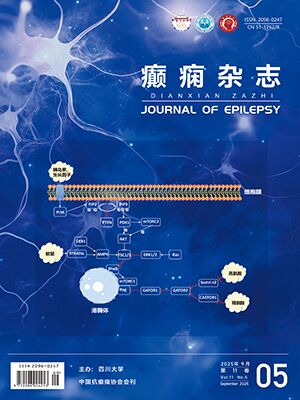| 1. |
Fiest KM, Sauro KM, Wiebe S, et al. Prevalence and incidence of epilepsy: a systematic review and meta-analysis of international studies. Neurology, 2017, 88(6): 296-303.
|
| 2. |
Vos T, Flaxman AD, Naghavi M, et al. Years lived with disability (YLDs) for 1160 sequelae of 289 diseases and injuries 1990-2010: A systematic analysis for the Global Burden of Disease Study 2010. Lancet, 2012, 380(9859): 2163-2196.
|
| 3. |
The World Health Organization Quality of Life Assessment (WHO- QOL): development and general psychometric properties. Soc Sci Med, 1998, 46(12): 1569-1585.
|
| 4. |
Kampra M, Tzerakis N, Lund Holm Thomsen L, et al. The challenges that parents of children with epilepsy face: A qualitative study. Epilepsy Behav, 2017, 71(Pt A): 94-103.
|
| 5. |
Ostendorf AP , Gedela S. Effect of epilepsy on families, communities, and society. Semin Pediatr Neurol, 2017, 24(4): 340-347.
|
| 6. |
Datta SS, Premkumar TS, Fielding S, et al. Impact of pediatric epilepsy on Indian families: Influence of psychopathology and seizure related variables. Epilepsy Behav, 2006, 9(1): 145-151.
|
| 7. |
Gibson PA. Lennox-Gastaut syndrome: Impact on the caregivers and families of patients. J Multidiscip Healthc, 2014, 7(1): 441-448.
|
| 8. |
O’Toole S, Lambert V, Gallagher P, et al. " I don’t like talking about it because that’s not who I am”: Challenges children face during epilepsy-related family communication. Chronic Illn, 2016, 12(3): 216-226.
|
| 9. |
Smith G, Wagner J, Andrews J, et al. Caregiving in pediatric epilepsy: Results of focus groups and implications for research and practice. Epilepsy Behav, 2014, 34: 34-41.
|
| 10. |
Abbas Z, Elseed MA, Mohammed IN. The quality of life among sudanese children with epilepsy and their care givers. Sudan J Paediatr, 2014, 14(1): 51-58.
|
| 11. |
Van Ande lJ, Westerhuis W, Zijlmans M, et al. Coping style and health- related quality of life in caregivers of epilepsy patients. J Neurol, 2011, 258(10): 1788-1794.
|
| 12. |
Ostendorf AP, Ng YT. Treatment-resistant lennox-gastaut syndrome: Therapeutic trends, challenges and future directions. Neuropsychiatr Dis Treat, 2017,13:1131-1140.
|
| 13. |
Hames A, Appleton R. Living with a brother or sister with epilepsy: Siblings’ experiences. Seizure, 2009, 18(10): 699-701.
|
| 14. |
Hallberg U. Situation and psychosocial well-being of older sisters to children with disabilities or chronic illnesses-the forgotten children?. Int J Qual Stud Health Well Being, 2013, 8: 21755.
|
| 15. |
Sharpe D, Rossiter L. Siblings of children with achronic illness: Ameta-analysis. J Pediatr Psychol, 2002, 27(8): 699-710.
|
| 16. |
Hoare P. Psychiatric disturbance in the families of epileptic children. Dev Med Child Neurol, 1984, 26(1): 14-19.
|
| 17. |
Rana P, Mishra D. Quality of life of unaffected siblings of children with chronic neurological disorders. Indian J Pediatr, 2015, 82(6): 545-548.
|
| 18. |
Vermaes IPR, van Susante AMJ, van Bakel HJA. Psychological functioning of siblings in families of children with chronic health conditions: A meta-analysis. J Pediatr Psychol, 2012, 37(2): 166-184.
|
| 19. |
Stephenson E, DeLongis A, Steele R, et al. Siblings of children with a complex chronic health condition: Maternal posttraumatic growth as a predictor of changes in child behavior problems. J Pediatr Psychol, 2017, 42(1): 104-113.
|
| 20. |
Pastor PN, Reuben CA, Kobau R, et al. Functional difficulties and school limitations of children with epilepsy: Findings from the 2009-2010 national survey of children with special health care needs. Disabil Health J, 2015, 8(2): 231-239.
|
| 21. |
Aguiar BVK, Guerreiro MM, McBrian D, et al. Seizure impact on the school attendance in children with epilepsy. Seizure, 2007, 16(8): 698-702.
|
| 22. |
Hunter RM, Reilly C, Atkinson P, et al. The health, education, and social care costs of school-aged children with active epilepsy: A population-based study. Epilepsia, 2015, 56(7): 1056-1064.
|
| 23. |
Allers K, Essue BM, Hackett ML, et al. The economic impact of epilepsy: A systematic review. BMC Neurol , 2015, 15(1): 245.
|
| 24. |
Puka K, Smith ML, Moineddin R, et al. The influence of socioeconomic status on health resource utilization in pediatric epilepsy in a universal health insurance system. Epilepsia, 2016, 57(3): 455-463.
|
| 25. |
Puka K, Smith ML, Moineddin R, et al. Health resource utilization varies by comorbidities in children with epilepsy. Epilepsy Behav, 2016, 57(Pt A): 151-154.
|
| 26. |
Leenen LA, Wijnen BF, de Kinderen RJ, et al. Cost-effectiveness of a multi-component intervention for adults with epilepsy: Study protocol of a dutch randomized controlled trial (ZMILE study). BMC Neurol, 2014, 17(7): 255.
|




